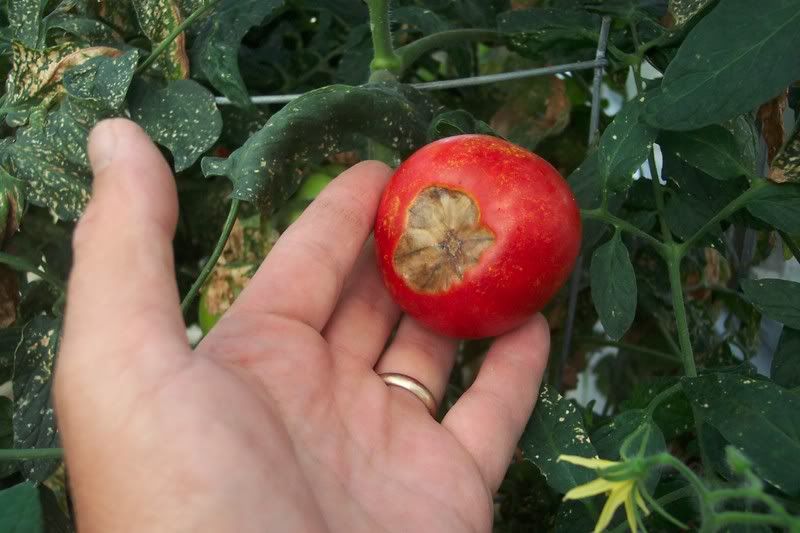This season’s warm temperatures have caused our tomato plants to grow like “crazy”. We have relatively high fertility in our garden beds and the tomatoes are regularly watered, hence all the growth.
All of these factors are setting us up for the potential of Blossom End Rot in our tomatoes.

The rapid growth causes the plants to have difficulty in taking up calcium from the soil. The lack of calcium in the plant during the time the tomato’s fruits are growing will cause Blossom End Rot.
It’s pretty disappointing to have grown all those beautiful plants with all those tomatoes on them and then have them start to rot right on the vine.
Sometimes even an experienced tomato farmer can lose nearly all of his crop to this problem.
What we are doing right now, is spraying a soluble form of calcium right on the leaves to ensure the plants get some supplemental calcium. You can find these sprays in most any garden center. We have been spraying about once or twice a week.
Calcium imbalance can also be caused by:
- Too much nitrogen in your garden soil (use low nitrogen fertilizer instead)
- Soggy soil, which causes root stress (plant in a well drained area)
- Cultivating too close to the plants, which destroys needed feeder roots
- Sudden lack of water after a period of plentiful water (irrigate evenly, mulching helps too)
- Low soil calcium levels occurring naturally (supplement your soil with lime,a common name for calcium, next fall)
Keep in mind that foliar sprays will not help Blossom End Rot once it starts.
Bob
Tomatoes can be fussy, can’t they?
Is it ok to pluck off the bottom few branches? Won’t that help focus energy on the top part where the fruit comes anyway?
Comment by victoria mcintyre — July 9, 2007 @ 2:48 pm
Maybe, in some cases.
The more leaves the plant has, the more surface area it has to absorb sunlight it needs for photosynthesis. The exception to this is when the plant becomes infected with Early Blight, a fungal disease which starts on the bottom branches. If the leaves are yellow with brown spots, you have Early Blight and the leaves are no longer useful to the plant. Otherwise, leave those leaves alone.
Comment by Bob — July 9, 2007 @ 10:38 pm
Oh great. Too late! Well, we’ll see. Hey, does the same go for pepper plants? Someone once told me to pinch the top part off. That doesn’t sound right.
Comment by victoria mcintyre — July 10, 2007 @ 1:02 pm
Same principle applies ;0
Comment by Bob — July 11, 2007 @ 7:31 pm
So that’s what’s been happening to our tomatoes. Only one particular plant has been affected – with the little tomatoes having rotten ends. I’ve been wondering about this for the last week.
I guess tomato plants need strong bones, too.
Comment by Stephanie A — July 13, 2007 @ 9:22 am
Stephanie, I just ran across an article about using milk as a calcium source for tomatoes. If I can find it again, I will post a blog on the subject.
Comment by Bob — July 16, 2007 @ 7:41 pm